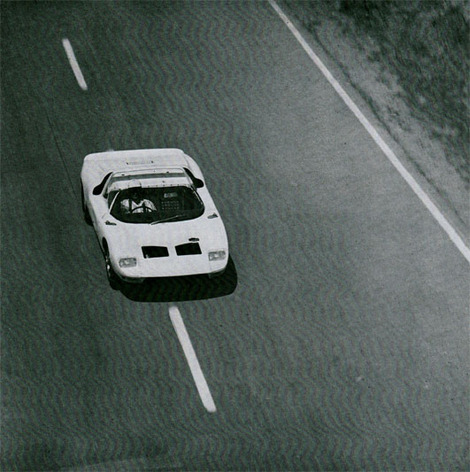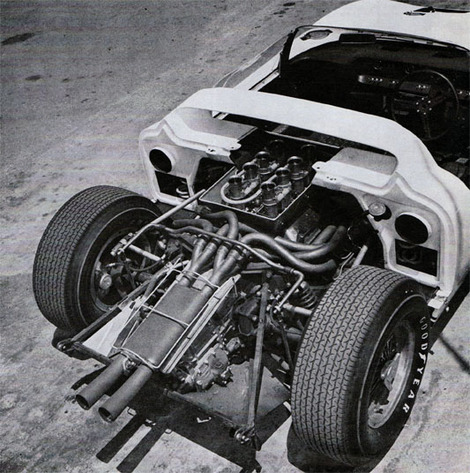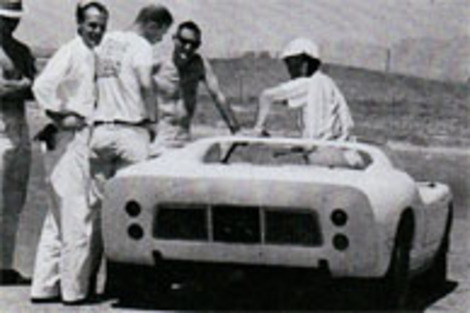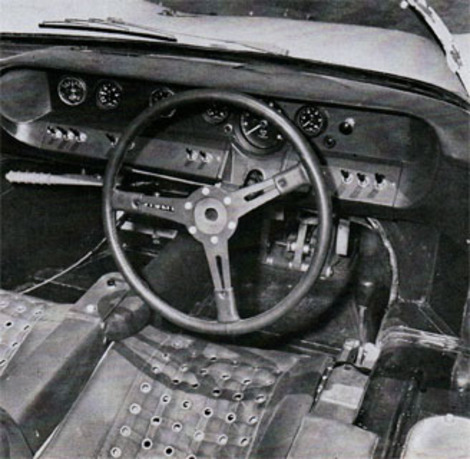TRACK TEST: Ford GT 40

TRACK TEST: Ford GT 40
by Jerry Titus
photos: Darryl Norenberg
 High-angle shot of the roadster reveals its very clean and efficient lines as it smokes down Riverside's back straight at over 150 mph.
High-angle shot of the roadster reveals its very clean and efficient lines as it smokes down Riverside's back straight at over 150 mph.
FOR OVER A YEAR AND A HALF SPORTS CAR GRAPHIC MAGAZINE has been reporting the development and campaigning of the Ford GT 40. Now it is approaching the time when those fabulous machines will be offered to the public. We started badgering Shelby-America's general manager Jim MacLean, for a track test of the Ford GT 40 just before LeMans. With the various cars being shuttled between Los Angeles, Dearborn, England and the Continent, it took a few months to arrange. The particular model we tested is called the roadster. It's identical to the coupe, but without the roof. It was equipped with a relatively tame version of the 289-inch high-performance V-8, and a Colotti four-speed transaxle. Ken MIles had it out at Riverside as a development car in a program that will determine in what final form it will be delivered to customers.
 Tuned-length exhaust system uses a resonator in secondary stage atop the four-speed Colotti. Note that the inner U-joints are metalastic type.
Tuned-length exhaust system uses a resonator in secondary stage atop the four-speed Colotti. Note that the inner U-joints are metalastic type.
We'd sat in the GT a couple of times before, but we were still impressed by the comfortable seats and driver positioning. Even though you sit deep between the stressed side sections housing some 39 gallons of gas and the narrow center tunnel, there still is an impression of considerable roominess due to the flat instrument panel and the relative lowness of the tunnel and tanks. The brake and clutch pedals are short, floor mounted affairs with the gas pedal hanging; the ideal setup for efficient heal-and-toe work. The steering wheel is leather bound, flat, and of moderate size, placed nicely for optimum control.
Equipped with downdraft Webers and the "bundle-of-snakes" exhaust system, the Ford produces that wild snarl with which the Indy cars chilled everyone. Only the sound of a sports/racing Ferrari at full chat is equal to it in sheer, savage noise. The engine fired up and even idles with unexpected docility. The multi-disc clutch was something else; either IN or OUT with very little between. Getting a heavy car off the line with this kind of setup is a ticklish job, and certainly nothing to have for around-town driving. It can be accomplished, but the clutch would not stand up to such abuse very long. COntained in a tight and positive pattern, the short gearshift lever is located on the right. It was connected to the first of the big Colotti gearboxes we've driven. It's non-synchro and takes more than a little practice to engage with out grinding, unless you're going flat out. Engine rpms MUST be matched with those of the gear shifts. Everything else is very easy to adapt to.

Underway, the heaviness (some 2200 pounds) is immediately apparent and accented by both the soft suspension and the general solidness of the vehicle. Taking it through Riverside's Esses, we found it extremely simple and dependable to control from the first lap onward. Steering pressure is slightly on the high side, and the general attitude definitely understeering. Tire bite and the ability to keep the tire on the ground over surface deviations was exceptionally good. By the time we got on the track, workmen were replacing the guardrail at Turn One, following installation of a new underpass. A full timed lap was impossible, but Ken had been out earlier and was cutting 1:36's; certainly not a top Modified time, but quicker than the best a competition Cobra could hack. It's rather hard to evaluate in this instance, as the test unit was neither fish nor foul, neither full-race nor tame enough for the street. There wasn't quite enough power for racing and the tires weren't the hot setup for that application, but the car got around the course like a thoroughbred. Aside from some judder that may have been an imperfect disc or an out-of-balance tire, stopping power was excellent, with good anti-dive characteristics making it deceptive as far as weight was concerned. The streamlining was evident from a stability standpoint, holding the roadster rock-steady on the straight.

 One of the most comfortable and efficient "offices" we've ever sat in. Gearshift is just to right of flat, leather-bound wheels. Pedals are on rack that can be adjusted to suit individual driver's needs. Red-line on this engine was 6500 rpm, but some 289's go higher.
One of the most comfortable and efficient "offices" we've ever sat in. Gearshift is just to right of flat, leather-bound wheels. Pedals are on rack that can be adjusted to suit individual driver's needs. Red-line on this engine was 6500 rpm, but some 289's go higher.
The Ford GT, in all, is quite a machine. A week after our test, Shelby shipped the test unit up to San Francisco to use as a pace car with Lew Spencer at the wheel. Lew started out slow but, by the time the ABC-Production event rolled around, we were really hard-pressed to keep up with him. "I can't help it," he said later, "that thing is such a ball to drive!" This, we feel, sums it up nicely.
From the Road America 2009 Kohler International with Brian Redman video a must see!!
A fantastic video from LeMan in a GT 40 from 1969.
A German video from 1966 LeMans of the wining Ford GT 40.
A 1969 video of LeMans and the Ford GT 40.
A very cool tribute video to the Ford GT 40.
Posted 03/13/10 @ 06:34 PM | Tags: Sports Car Graphic magazine, Sports Car Graphic magazine May 1966, Sport Car Graphic magazine October 1965, Ford GT 40, Ford GT 40 street version, Jim MacLean general manager Shelby-America, Shelby America, Shelby GT40, Colotti four-speed transaxle, Ken Miles, Riverside raceway, downdraft Webers, Lew Spencer, Carroll Shelby